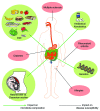The interplay between the gut microbiota and the immune system
- PMID: 24922519
- PMCID: PMC4153781
- DOI: 10.4161/gmic.29330
The interplay between the gut microbiota and the immune system
Abstract
The impact of the gut microbiota on immune homeostasis within the gut and, importantly, also at systemic sites has gained tremendous research interest over the last few years. The intestinal microbiota is an integral component of a fascinating ecosystem that interacts with and benefits its host on several complex levels to achieve a mutualistic relationship. Host-microbial homeostasis involves appropriate immune regulation within the gut mucosa to maintain a healthy gut while preventing uncontrolled immune responses against the beneficial commensal microbiota potentially leading to chronic inflammatory bowel diseases (IBD). Furthermore, recent studies suggest that the microbiota composition might impact on the susceptibility to immune-mediated disorders such as autoimmunity and allergy. Understanding how the microbiota modulates susceptibility to these diseases is an important step toward better prevention or treatment options for such diseases.
Keywords: IgA; allergies; autoimmunity; homeostasis; innate lymphoid cells; microbial conditioning; microbiota; regulatory T cells.
Figures


References
-
- Dominguez-Bello MG, Costello EK, Contreras M, Magris M, Hidalgo G, Fierer N, Knight R. Delivery mode shapes the acquisition and structure of the initial microbiota across multiple body habitats in newborns. Proc Natl Acad Sci U S A. 2010;107:11971–5. doi: 10.1073/pnas.1002601107. - DOI - PMC - PubMed
Publication types
MeSH terms
Grants and funding
LinkOut - more resources
Full Text Sources
Other Literature Sources
Medical
Miscellaneous
